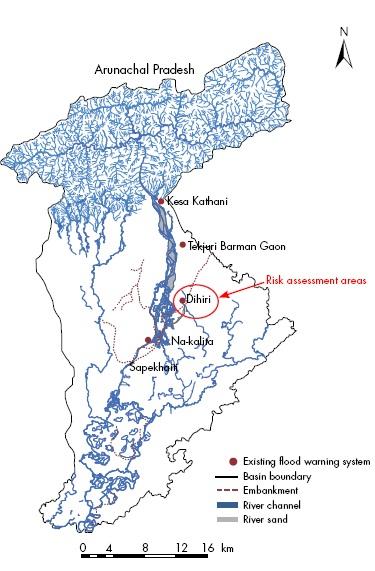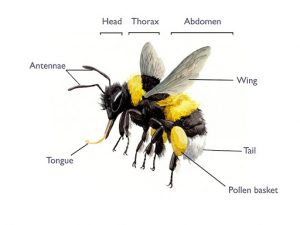 |
||
| 16 April 2024 | ||
|
- India’s Interest in the Arctic
- Understanding Exoatmospheric Interception
- The Jiadhal River’s Changing Course
- The Real Estate (Regulation and Development)
- Exercise Dustlik-2024
- Understanding Bumblebees
India’s Interest in the Arctic
Context;
The Arctic region boasts rich energy resources, encompassing oil, natural gas, and various renewable sources like wind, solar, hydro, geothermal, and tidal power. It spans an area of around 8 million square kilometers and is governed by countries including Denmark, Canada, Iceland, Finland, Russia, Norway, Sweden, and the United States.

Drivers of India’s Arctic Focus:
- Several factors motivate India’s heightened interest in the Arctic.
- Firstly, concerns over climate change have accelerated India’s focus on the region, spurred by scientific evidence highlighting rapid warming.
- Additionally, India sees potential trade advantages in utilizing Arctic sea routes, particularly the Northern Sea Route, to enhance its trade efficiency.
- Geopolitical dynamics, such as China’s expanding presence and Russia’s decisions on Arctic access, also contribute to India’s strategic interest.
Historical Engagement:
- India’s historical engagement in the Arctic dates back to the 1920 signing of the Svalbard Treaty.
Future Collaborative Opportunities:
- India aims to foster collaboration with Arctic nations, notably Norway, particularly in the realms of green energy and clean industries.
- This aligns with India’s aspiration to be a responsible global player in environmental initiatives.
- Partnering with Norway could offer transformative opportunities for India, including increased involvement in Arctic Council working groups.
Focus Areas for Collaboration:
- Cooperation with Norway is expected to focus on scientific research, climate, and environmental protection, in line with India’s Arctic Policy objectives.
- Addressing environmental challenges through joint research and cooperation remains a key pillar of India’s approach to the Arctic.
Understanding Exoatmospheric Interception
Introduction:
Exoatmospheric interception involves intercepting targets beyond Earth’s atmosphere. Recent news highlights Israel’s successful interception of an Iranian missile using an Exoatmospheric kill vehicle. Israel’s multi-layered air defense system, including Iron Dome, The Arrow, and David’s Sling, was activated to counter the threat.

Israel’s Air Defense Systems:
Israel’s air defense comprises several systems:
1.Iron Dome: Designed to intercept short-range threats like rockets, mortars, and drones.
2.Arrow: Intercepting ballistic missiles outside the atmosphere.
3.David’s Sling: Intercepting mid-range threats like ballistic missiles, aircraft, drones, and cruise missiles.
Overview of Exoatmospheric Missiles:
Exoatmospheric missiles, or anti-ballistic missiles (ABMs), operate beyond Earth’s atmosphere to intercept incoming ballistic threats. They utilize advanced sensors and guidance systems.

Working Mechanism:
- Exoatmospheric missiles employ kinetic kill vehicles like the Exoatmospheric Kill Vehicle (EKV), which rely on high-speed collisions to neutralize threats.
- They travel at hypersonic speeds, propelled by solid rocket boosters. Onboard sensors and computers identify and track incoming threats, enabling precise maneuvering towards targets.
Advantages of Exoatmospheric Interception:
Exoatmospheric interception enhances speed and accuracy without traditional warheads, thereby increasing efficiency in neutralizing threats.
The Jiadhal River’s Changing Course
Overview;
The disruption of the Jiadhal River’s flow due to climate change is making headlines, as it undergoes unprecedented shifts in its course, causing disturbances for residents in Assam’s Dhemaji district.

Introduction to Jiadhal River:
- The Jiadhal River, also known as the Kumotiya River downstream from Gogamukh, flows through Assam’s Darrang, Udalguri, and Baksa districts.
- Originating from the hills of Bhutan, it traverses the Assam Himalayas before meandering across the plains.
- Its formation occurs at the confluence of multiple smaller streams, with notable tributaries including the Kolong River and the Daokao River.
- Ultimately, it merges with the Brahmaputra River near Nalbari. Locals often refer to it as the ‘Sorrow of Dhemaji’ due to the significant damage caused by annual floods and erosion.
Factors Influencing Course Changes:
Various factors contribute to the alterations in the Jiadhal River’s course:
1.Erosion: Continuous flow erodes riverbanks and beds, prompting meandering and directional changes.
2.Sediment Deposition: Accumulated sediment can form new channels or modify the river’s flow pattern.
3.Human Impact: Human activities like dam construction, urban development, deforestation, and mining disrupt natural river processes, affecting flow dynamics and morphology.
4.Climate Change: Changes in precipitation, temperature, and glacier melting influence river behavior and flow patterns.
5.Tectonic Activity: Geological phenomena such as uplift, subsidence, and faulting affect river topography and drainage, leading to course adjustments.
Conclusion:
Understanding these factors is crucial for addressing the challenges posed by the Jiadhal River’s changing course and mitigating its impacts on local communities and ecosystems.
The Real Estate (Regulation and Development)
Context:
The Ministry of Housing and Urban Affairs is currently engaged in assessing the implementation of the Real Estate (Regulation and Development) Act, 2016.
Overview of RERA;
- Introduced by the Government of India in 2016, the Real Estate (Regulation and Development) Act (RERA) aims to regulate the real estate sector, foster transparency, accountability, and efficiency in transactions, safeguard the interests of homebuyers, and promote fair practices in the industry.

Significance:
- Discussion on regulating the real estate sector initiated in 2013, culminating in the establishment of the RERA Act in 2016.
- Investment Data reveals over 77% of an average Indian household’s total assets are in real estate, making it the largest individual investment.
- Before RERA, the sector operated with limited regulation, necessitating the introduction of the Act to enhance consumer protection, reduce frauds and delays, and facilitate fast-track dispute resolution.
Major Provisions of RERA:
- Establishment of State-Level Regulatory Authorities tasked with registering and maintaining a database of real estate projects, protecting the interests of all stakeholders, and advising the government.
- Creation of Real Estate Appellate Tribunals for appeals against RERA decisions.
- Mandatory registration of projects meeting specified criteria.
- Requirement for developers to deposit 70% of collected funds in separate escrow accounts.
- Developer liability for structural defects for five years.
- Imposition of penal interest in case of default and a cap on advance payments.
- Clear definitions of carpet area and built-up area to ensure transparency.
- Prescribed punishments for violations.
Implementation Status:
- Most States/UTs have notified Rules under RERA.
- Regulatory Authorities and Appellate Tribunals have been established in the majority of States/UTs.
3. Significant numbers of projects and agents have been registered, and complaints resolved nationwide.
Reasons for Government Review:
- Assessment of RERA’s effectiveness in enhancing transparency, accountability, and grievance redressal.
- Collection of stakeholder feedback to identify areas for improvement.
- Establishment of a data collection unit to gather insights into RERA’s functioning.
- Aim for uniformity in information dissemination and greater compliance with Act provisions.
- Addressing concerns such as insufficient information on RERA websites and project registration without document verification.
6. Laying the groundwork for potential amendments to enhance RERA’s effectiveness.
Exercise Dustlik-2024
Overview:
The Indian Army contingent recently embarked on the 5th iteration of the India-Uzbekistan joint military Exercise DUSTLIK.
About Exercise Dustlik:
- DUSTLIK is an annual joint military exercise conducted alternately in India and Uzbekistan between the Indian Army and the Uzbekistan Army.
- Its inaugural edition took place in Uzbekistan in November 2019, and the most recent iteration occurred in Pithoragarh in February 2023.
Dustlik-2024:
- This year marks the fifth edition of the joint exercise, which will be held in Termez, Uzbekistan.
- The Indian Armed Forces contingent, consisting of 60 personnel, includes 45 individuals from the Indian Army, primarily from a battalion of the JAT Regiment, and 15 personnel from the Indian Air Force.

- The Uzbekistan contingent, comprising around 100 personnel from the Uzbekistan Army and Air Force, will be represented by personnel from the Southern Operational Command, a part of the South-West Military District.
- The objective of Exercise DUSTLIK is to bolster military cooperation and improve combined capabilities for executing joint operations in mountainous and semi-urban terrains.
- It will emphasize high levels of physical fitness, joint planning, joint tactical drills, and the fundamentals of special arms skills
- This edition of Exercise DUSTLIK introduces enhanced complexity through the execution of multi-domain operations, with the participation of combat support arms and services in addition to infantry units.
Understanding Bumblebees
Overview:
Recent research suggests that bumblebees display a notable resilience to common pesticides.

About Bumblebees:
- Bumblebees, belonging to the family Apidae (subfamily Bombinae), are large, hairy social bees.
- The Apidae family encompasses various bee species, including honey bees, carpenter bees, cuckoo bees, digger bees, stingless bees, and orchid bees.
Distribution:
- Found across much of the globe, bumblebees are most prevalent in temperate regions.
- With over 250 recognized species, they primarily inhabit the Northern Hemisphere.
- Renowned for their role in collecting nectar from flowers and facilitating plant pollination.
Features:
- These insects are characterized by their large size, yellow and black coloration, and distinctive buzzing sound.
- Bumblebee species exhibit variations in color, with some displaying bands of red, yellow, and black. Their stocky bodies are covered in dense hairs, aiding in pollen collection.
- Bumblebees possess four wings, with the rear wings typically smaller and attached to the forewings by hook-like structures called hamuli. Their wings beat rapidly, at speeds ranging from 130 to 240 beats per second.
Social Structure:
- Bumblebees live in colonies, exhibiting a social structure similar to that of honeybees. Within the colony, the queen bee, drones, and worker bees each fulfill specific roles to support the community.
- Unlike honeybees, bumblebees do not produce honey as they do not store food for winter.
- Instead, new queens hibernate during the season and emerge in spring to establish their own nests.

